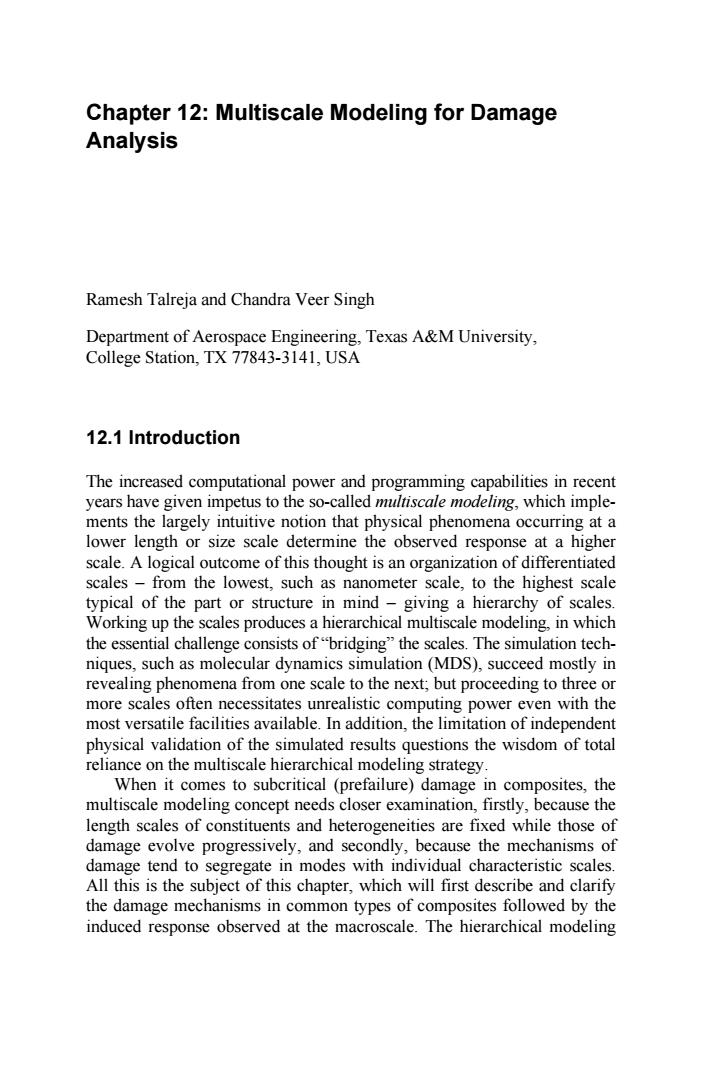正在加载图片...

Chapter 12:Multiscale Modeling for Damage Analysis Ramesh Talreja and Chandra Veer Singh Department of Aerospace Engineering,Texas A&M University, College Station,TX 77843-3141.USA 12.1 Introduction The increased computational power and programming capabilities in recent years have given impetus to the so-called multiscale modeling,which imple- ments the largely intuitive notion that physical phenomena occurring at a lower length or size scale determine the observed response at a higher scale.A logical outcome of this thought is an organization of differentiated scales-from the lowest,such as nanometer scale,to the highest scale typical of the part or structure in mind-giving a hierarchy of scales. Working up the scales produces a hierarchical multiscale modeling,in which the essential challenge consists of"bridging"the scales.The simulation tech- niques,such as molecular dynamics simulation (MDS),succeed mostly in revealing phenomena from one scale to the next;but proceeding to three or more scales often necessitates unrealistic computing power even with the most versatile facilities available.In addition,the limitation of independent physical validation of the simulated results questions the wisdom of total reliance on the multiscale hierarchical modeling strategy. When it comes to subcritical (prefailure)damage in composites,the multiscale modeling concept needs closer examination,firstly,because the length scales of constituents and heterogeneities are fixed while those of damage evolve progressively,and secondly,because the mechanisms of damage tend to segregate in modes with individual characteristic scales All this is the subject of this chapter,which will first describe and clarify the damage mechanisms in common types of composites followed by the induced response observed at the macroscale.The hierarchical modelingChapter 12: Multiscale Modeling for Damage Analysis Ramesh Talreja and Chandra Veer Singh Department of Aerospace Engineering, Texas A&M University, College Station, TX 77843-3141, USA 12.1 Introduction The increased computational power and programming capabilities in recent years have given impetus to the so-called multiscale modeling, which implements the largely intuitive notion that physical phenomena occurring at a lower length or size scale determine the observed response at a higher scale. A logical outcome of this thought is an organization of differentiated scales – from the lowest, such as nanometer scale, to the highest scale typical of the part or structure in mind – giving a hierarchy of scales. Working up the scales produces a hierarchical multiscale modeling, in which the essential challenge consists of “bridging” the scales. The simulation techniques, such as molecular dynamics simulation (MDS), succeed mostly in revealing phenomena from one scale to the next; but proceeding to three or more scales often necessitates unrealistic computing power even with the most versatile facilities available. In addition, the limitation of independent physical validation of the simulated results questions the wisdom of total reliance on the multiscale hierarchical modeling strategy. When it comes to subcritical (prefailure) damage in composites, the multiscale modeling concept needs closer examination, firstly, because the length scales of constituents and heterogeneities are fixed while those of damage evolve progressively, and secondly, because the mechanisms of damage tend to segregate in modes with individual characteristic scales. All this is the subject of this chapter, which will first describe and clarify the damage mechanisms in common types of composites followed by the induced response observed at the macroscale. The hierarchical modeling